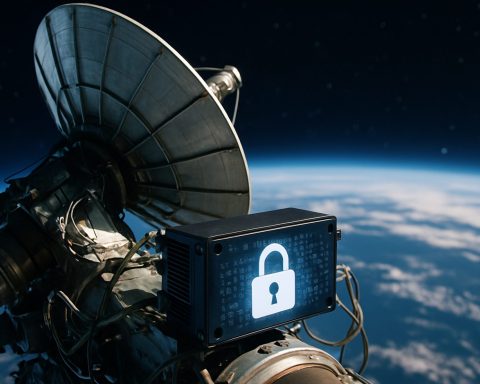- The U.S. Space Force has selected Rocket Lab and Stoke Space for a $5.6 billion launch program to enhance national security in space.
- Rocket Lab’s Neutron, built with cutting-edge materials, aims to deliver payloads of up to 13 metric tons to orbit from Wallops Island, Virginia, with its inaugural flight in late 2025.
- Stoke Space’s Nova, featuring a fully reusable design, celebrated success with its Zenith engine, positioning the company as a notable newcomer in space exploration.
- Both companies will receive an initial $5 million to prepare for missions under the Space Systems Command’s oversight.
- The National Security Space Launch Phase 3 program offers diverse pathways, encouraging newer and established firms to engage in innovative mission designs.
- Success in Lane 1 could lead to greater opportunities and integration with Pentagon initiatives for Rocket Lab and Stoke Space.
- The Space Force seeks to expand launch capabilities and incorporate fresh perspectives by welcoming additional participants by fiscal year 2026.
A significant launch looms over the cosmos as Rocket Lab and Stoke Space prepare to ascend to new heights in the fiercely competitive world of national security space contracts. In an ambitious move, the U.S. Space Force has broadened its celestial horizons by selecting these pioneering firms to partake in a sprawling $5.6 billion launch program, set to redefine military access to the stars.
Against the backdrop of a swiftly evolving space landscape, Rocket Lab, a name synonymous with innovation, embarks on an advanced journey with their ambitious creation, Neutron. This rocket, composed with cutting-edge materials, aims to carry hefty payloads of up to 13 metric tons into orbit, promising reusable possibilities that edge closer to practicality with each trial. With the storied coastlines of Wallops Island, Virginia, earmarked for its inaugural flight in late 2025, Neutron stands as a testament to Rocket Lab’s commitment to a more sustainable spacefaring future.
Vying alongside Rocket Lab, Stoke Space emerges onto the scene, setting a rare precedent with its vision of a fully reusable rocket, Nova. Amidst the clangor of rigorous engineering triumphs, Stoke recently celebrated a landmark success, firing Zenith, the ambitious engine at the heart of Nova’s design. This heralds a new dawn for Stoke Space—a newcomer determined to leave a profound imprint on the universal stage.
These exciting entrants will receive an initial $5 million to fine-tune their launch capabilities under the scrupulous gaze of the Space Systems Command. The task involves devising a comprehensive mission assurance process, ensuring their readiness to safely deliver sensitive payloads into orbit.
The strategic structuring of the National Security Space Launch (NSSL) Phase 3 program unveils dual pathways designed to accommodate both newer companies and established titans. Rocket Lab and Stoke Space will contend in Lane 1, a realm dedicated to missions reaching low Earth orbit, potentially crafting their access to high-security engagements and cultivating a nurturing ground for innovation.
Amid this expansion, the Space Force signals a commitment to amplifying the nation’s launch capacity through diversity and ingenuity, infusing fresh perspectives into its strategic vision. By welcoming Rocket Lab and Stoke Space into its fold, the military anticipates a renaissance of ideas, fostering increased competition as the universe above becomes the next great frontier.
For these emerging providers, triumph in Lane 1 could evoke transformative opportunities, opening the door for future assignments and further integration with Pentagon initiatives. As these new players prepare to make their mark, the cosmos beckons, brimming with possibilities yet undreamt.
Pathways continue to widen as the Space Force aims to invigorate its ranks with additional participants by early fiscal year 2026. Until then, the eyes of the world wait with bated breath, following Rocket Lab and Stoke Space, as they set their sights on the stars, ready to etch their narratives into the expansive tapestry of space exploration.
New Horizon in Space Exploration: Rocket Lab and Stoke Space’s Emerging Role in National Security Launches
Overview
In an era where the cosmos is the new frontier for national security, Rocket Lab and Stoke Space are poised to revolutionize access to space through cutting-edge innovations and strategic government partnerships. With the U.S. Space Force allocating a $5.6 billion launch program, these burgeoning companies stand at the forefront of the industry, challenging the status quo with novel technologies and approaches.
Key Technologies and Innovations
– Rocket Lab’s Neutron: This next-generation reusable rocket boasts the capability of delivering payloads up to 13 metric tons into orbit. Constructed with breakthrough materials, Neutron aims for its inaugural launch by 2025 from Wallops Island, Virginia. Its reusability aspect underscores Rocket Lab’s commitment to economic viability and environmental sustainability in space exploration.
– Stoke Space’s Nova: Pioneering the concept of a fully reusable rocket, Stoke Space’s Nova is powered by the Zenith engine, a recent highlight of their engineering accomplishments. Nova’s design promises complete reusability, a leap toward reducing costs and turnaround time for launches, thus enabling more frequent and sustainable access to space.
Pressing Reader Questions
1. What does the $5.6 billion Space Force Program entail?
This funding aims to secure diverse and innovative launch capabilities to safeguard national interests in space. Rocket Lab and Stoke Space were selected to participate in developing technologies to support missions mostly focusing on low Earth orbit payload delivery.
2. How do Neutron and Nova differ from other rockets?
While traditional launch providers offer partially reusable or one-time-use rockets, Neutron and Nova are designed for high reusability. This approach significantly reduces costs per launch, enhances sustainability, and could accelerate the pace of establishing a commercial space environment.
3. What opportunities does Lane 1 of the NSSL Phase 3 program present?
Lane 1 focuses on developing newer capabilities for low Earth orbit missions. Success here could lead to subsequent contracts, moving Rocket Lab and Stoke Space toward more profound collaborations with the Pentagon and broader military objectives.
Market Trends and Future Insights
The space launch industry, valued at nearly $10 billion in 2021, is expected to experience significant growth, spurred by increased government investment and commercial demand. Pioneers like Rocket Lab and Stoke Space are anticipated to benefit from this trend, as they offer more sustainable and cost-effective solutions compared to traditional aerospace giants.
Real-World Applications
For national security, the ability to swiftly and affordably deliver payloads into orbit is crucial. This can enhance satellite deployment for surveillance, GPS navigation, and communication, providing strategic edges in both military and civilian scenarios.
Expert Recommendations
1. For Investors: Consider diversifying your portfolio with space tech stocks. Monitor how Rocket Lab and Stoke Space perform, particularly as they advance through the NSSL’s phases.
2. For Industry Stakeholders: Collaborate and engage with emerging companies. Their innovations can complement existing technologies and offer cost-effective solutions for complex problems.
3. For Innovators and Engineers: Focus on enhancing the reusability and turnaround time of rockets. The market is ripe for solutions that reduce environmental impact while maintaining or increasing launch frequency.
Conclusion
Rocket Lab and Stoke Space’s ascendancy in the national security space launch realm signals a bright future filled with potential breakthroughs in technology and strategic space operations. These companies are not only poised to reshape the aerospace landscape but could also redefine how nations across the globe perceive and prioritize access to space.
For further information, visit Rocket Lab and Stoke Space. These pioneering firms symbolize the industry’s momentum toward an innovative, sustainable, and more accessible future in space exploration.








